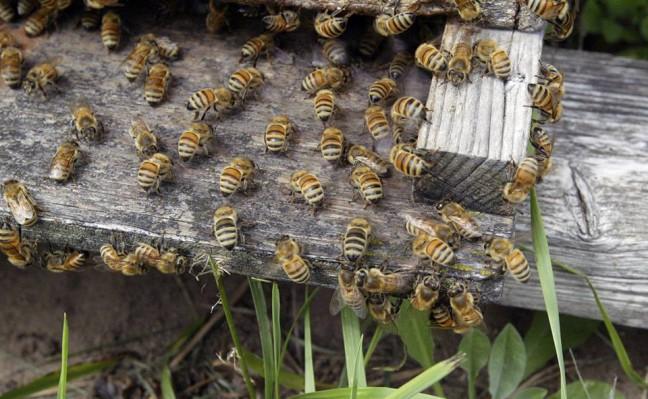See a bee? Mark it on WiBee! A new smartphone app developed by the Gratton Lab at the University of Wisconsin harnesses the power of citizen science and community efforts to track wild bee populations and diversity.
The WiBee project is led by principal investigators Professor Claudio Gratton and Hannah Gaines Day. Having conducted research with farmers and growers across Wisconsin, a common question asked by growers was whether there were sufficient bees on the farm to pollinate crops, particularly during apple blooms.
There is only a short time frame for bees to pollinate when apples are blossoming. Day said it happens one to two weeks in the springtime with the weather being super finicky.
“In Wisconsin, you might have some days where it’s really nice,” Gratton said. “Bees like to fly when it’s sunny, not a lot of wind and the temperature kind of warm. Then half an hour later, the clouds have moved over, temperatures dropped, it’s drizzly and the bees don’t fly.”
Gratton said when they drive to the farms and bees aren’t flying, they don’t know if they arrived at a bad time or if they’re just not there.
That variability made it hard for a limited team to make many measurements, Gratton said. That’s how his team developed the idea for an app.
“Having a small research team it’s really hard to get enough data to be able to tell the growers if they have enough bees or not,” Day said. “And so, we thought, what if we get the growers to collect data for us because they’re all out at the farms anyway?”
On days when the weather’s good, farmers run out and do a survey. WiBee can be used as a notebook of the user’s observations, wherever they’ve made them. Farmers can compare bee populations in their orchards by year and find correlations to temperature or precipitation, Day said.
The data collected by WiBee is compiled onto the Pollinators website and made available to the public. Farmers can find observations that others made and filter for time and crop species through the data portal. The app allows growers to see broader patterns across the state or over the season that you might not see from their own observations, Day said.
Another aim of WiBee is to identify whether wild bee populations are enough to pollinate apples during the blossoming period, Gratton said. Since apple blooms take place over a short timeframe, many apple growers will rent bees and bring them to their orchard at an additional expense.
“One of the things that we’ve been interested in our group is what parts of our Wisconsin agricultural landscape support large enough populations of those native wild bees to actually provide sufficient pollination for apples?” Gratton said. “Could you get away with just using wild bees? And what kinds of places might be the best places for apple growers to be in to have that free service?”
With over 500 species of wild bees in Wisconsin, some species of bees are more effective pollinators, Day said. They can transfer more pollen on a single visit than other bees and be specialists at pollinating certain types of plants.
Day said some bee pollinators are habitat specialists that might prefer disturbed areas with weedy species. Others may prefer the ephemeral plants of the woodlands and only fly for a few weeks in the springtime.
Those species of bees would never be found in a prairie or in a farm field because they only live in the woods in the springtime, Day said.
On the farm, honeybees are often the choice bee pollinators. Honeybees are often used by growers as they’re relatively easy to manage, Day said. They are generalist pollinators so they will visit any flowers, while wild species are a little bit picky on which flowers they want to visit.
According to Day, smaller bees might fly lower to the ground and bigger bees fly higher up in a tree canopy on a windy day. The temperature and precipitation also affect bee behavior and their pollinating habits.
Bumblebees will fly when it’s cooler and wetter than honeybees, Day said.
“Oftentimes these different species complement each other because of their behavior and preferences pollinating,” Day said.
One of the goals of WiBee is to continue collecting more data and make more confident statements about whether farmers have enough pollinators, said WiBee Project Coordinator Colleen Satyshur.
Further landscape analysis in relation to the data can direct both conservation and farm management, Satyshur said.
Looking at the contrast between observations of the same flower in an urban area compared to a more agricultural area can help inform conservation efforts, Gratton said.
“People in and around towns plant a lot of flowers,” Gratton said. “There’s less agricultural chemicals used, there’s less disturbance of the soil. Maybe urban areas actually are a potential place where we can do bee conservation.”
All it takes is five minutes, Satyshur said.
Community scientists can help collect a lot more data in ways that a specialist team often cannot, Gratton said. The hope is to bring the science together with the data collected by community partners and offer future management recommendations.
“There’s a lot of things that we can learn by getting engaged and participating in a project like this,” Gratton said. “And hopefully, the flip side is you get to learn something about these little creatures that we share our landscapes with.”
Satyshur said the Lakeshore Path and the Allen Centennial Gardens are excellent areas to spot bees.
“I always appreciate it when I have a moment to just sit and watch, watch the world around us,” Gratton said. “I hope everybody can have an opportunity to do that.”
To learn more about WiBee on the pollinators website or better you can download the app.


